As an Amazon Associate I earn from qualifying purchases.
This chile verde recipe is my go-to Mexican comfort food, easy to make and it keeps well all week. If you’re not familiar with it, Chile verde is braised meat with lots of green elements, like green chiles, cilantro and other herbs, as well as tomatillos.
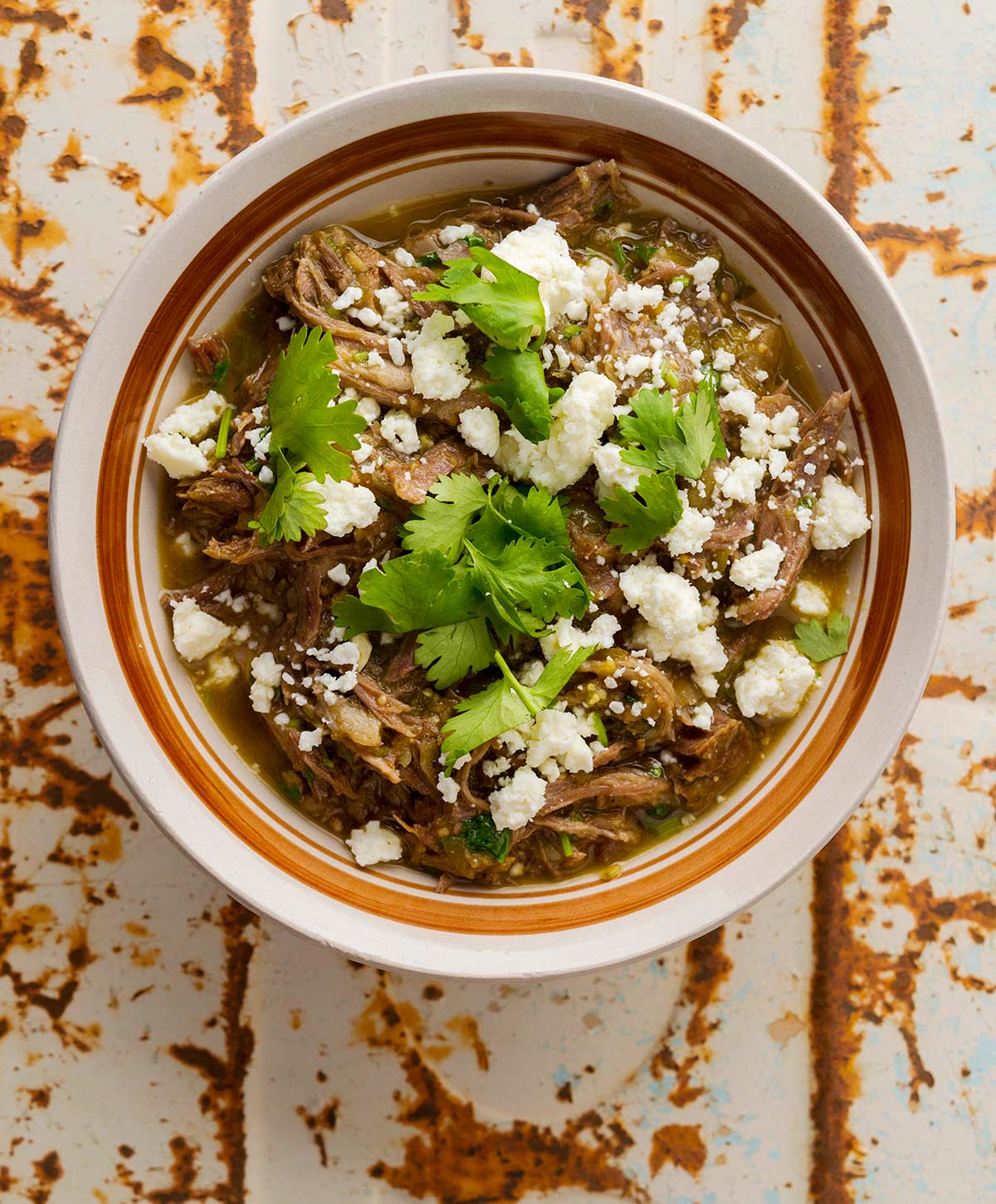
I should be clear at the start that chile verde is not green chili, nor is it the New Mexican dish green chile stew. Those are great dishes, but they are American. Chile verde is Mexican.
It is a staple in Mexican restaurants around here. This chile verde recipe is based on several I’ve read, or eaten in the Sonoran Desert area around Arizona, although there are variations on this dish all over both Mexico and our own Desert Southwest.
Wherever it comes from, this is a damn good dish, up there with my chile colorado and venison chili.
Chile Verde Ingredients
Unlike green chili or green chile stew, Mexican chile verde requires tomatillos, those cousins of the tomato you see encased in a papery husk. They come in many varieties, from great big domesticated ones to these funny little tomatillos that grow in my garden.
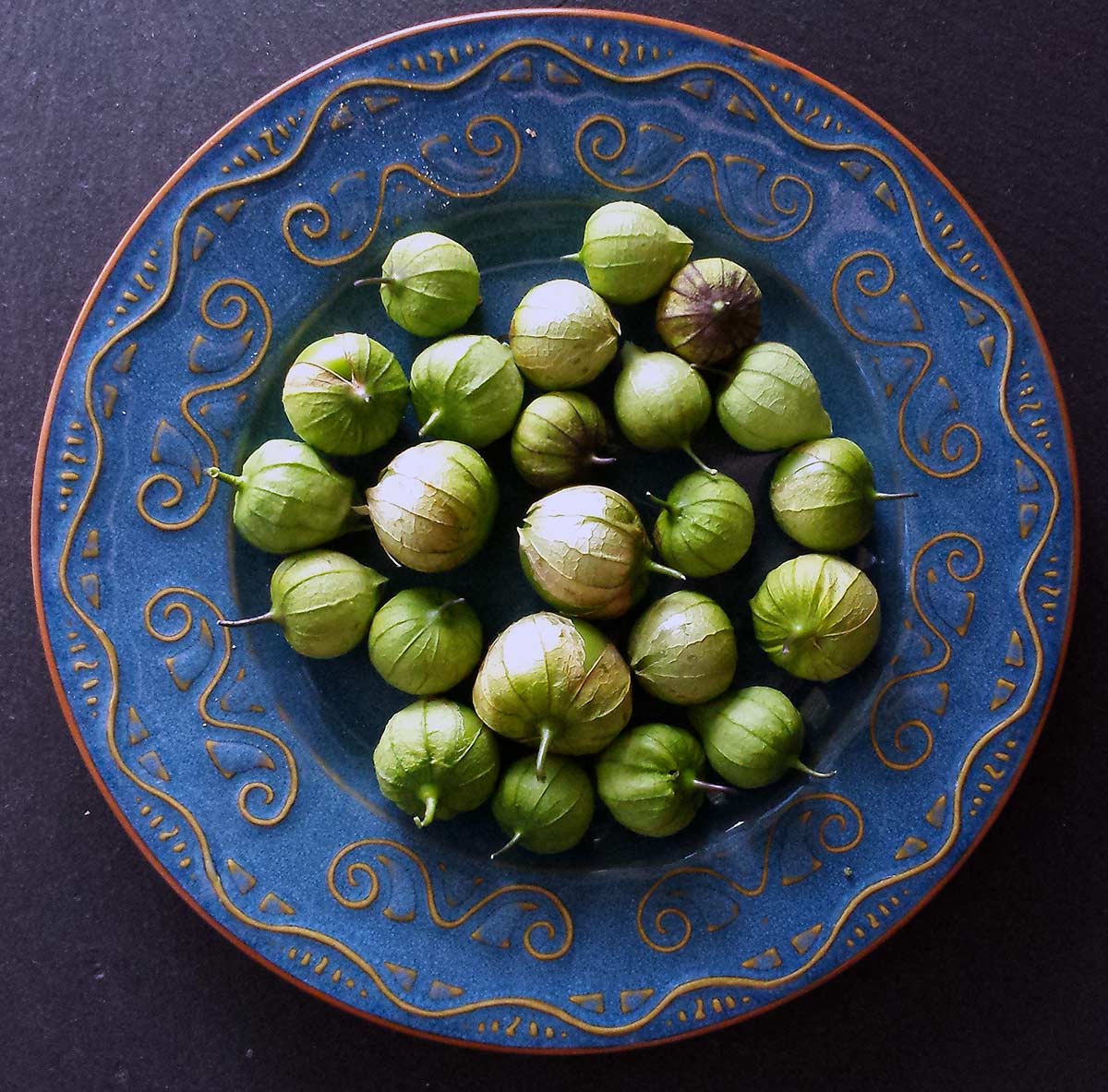
I never planted them. They just appeared. Lots of gardeners in my neighborhood get them, so I think they are wild, or at least feral. There do happen to be a number of various “ground cherry” species growing all over the country, so I am not certain which one this is. All I can tell you is that this is a welcome weed.
So whenever they’re ripe, I pick masses of the little buggers. You can find them in Mexican markets sold as tomatillos de milpa.
You strip off the husk, and inside is a kinda sticky green tomato-like thing. When they get perfect, the fruit fills the husk and sticks to it, so sometimes you may need to husk them under cold water. You want tomatillos when they are green and unripe; these turn purple when they are dead ripe, and the big ones turn sort of creamy-yellow.
When I am inundated with tomatillos, I make loads of my tomatillo salsa verde, which is great on tortilla chips, and can it. This is key, because, once canned, you have almost instant chile verde.
Other than tomatillos, you need other green ingredients: cilantro and a couple kinds of green chiles. I use a mix of Anaheim and/or poblano chiles, plus serranos or jalapenos for heat. In late summer, I get access to green Hatch chiles, which, when hot, take care of all your green chile needs.
The Sauce
Making chile verde sauce is kind of a production, like most good Mexican sauces. (Ever make mole? Not easy.) You put the peppers, onion, tomatillos and garlic on a grill or under a broiler to char, then peel the garlic and chiles — both hot and mild — cilantro, etc. and chop up everything in a food processor.
As I mentioned above, you can do all this way ahead of time by making salsa verde and canning it.
Once you have your salsa verde, making chile verde is easy. Keep in mind that tomatillos are acidic. For geeks, their average pH is 3.8, which is only a little milder than an orange. This means your chile verde will be acidic, too. So go easy on the lime until you’ve tasted it.
If you end up with sour chile verde, serve it with sour cream or Mexican crema. Yes, those are sour, too, but the dairy helps a lot.
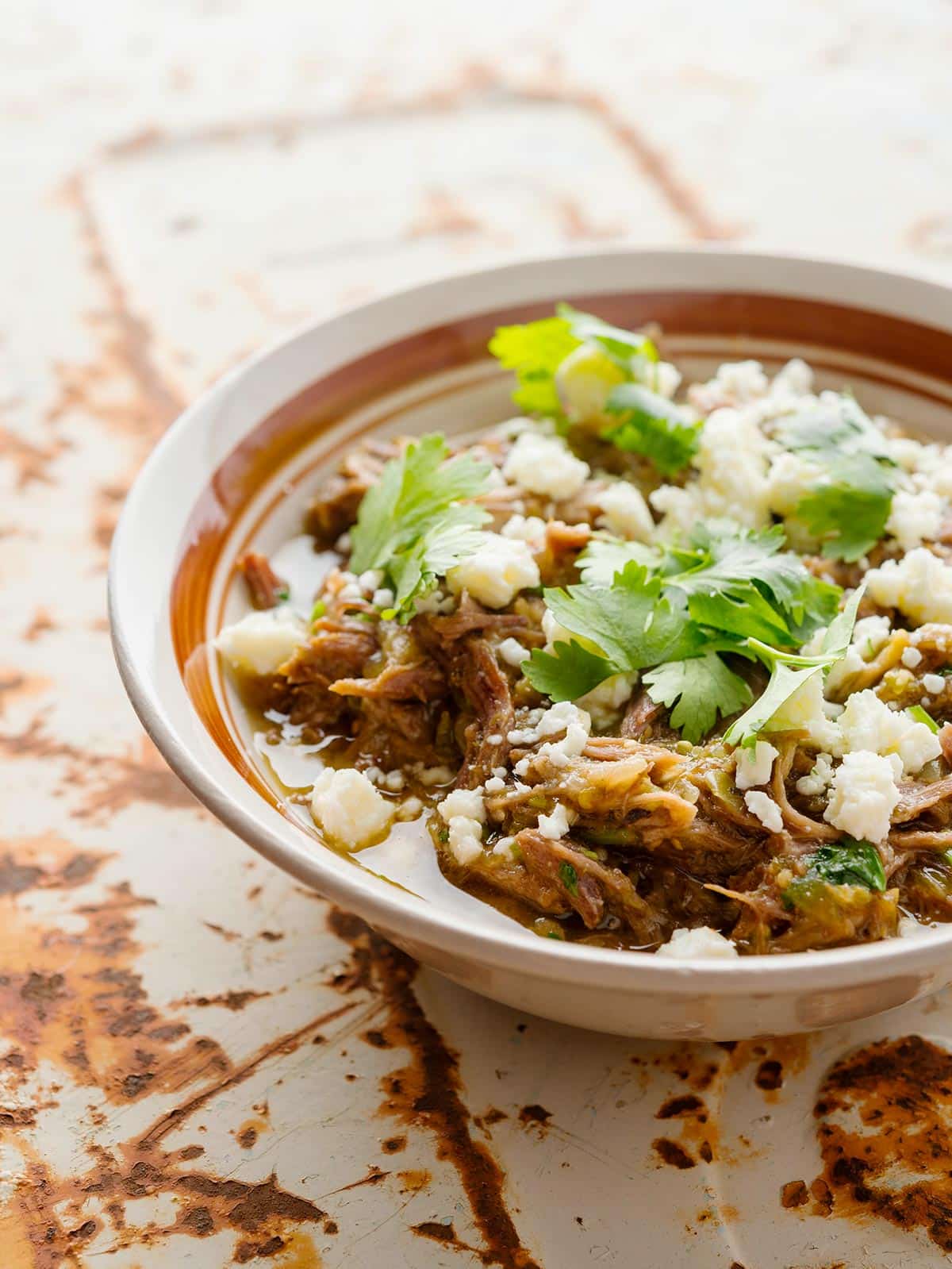
Meat in Chile Verde
Meat is up to you. Think pork first, wild or domesticated. Chicken, pheasant, turkey (wild or domestic) are other good choices. Think light meat first, although I will admit, it’s damn good with beef, venison and yes, even things like squirrels or jackrabbits. Play with it!
I serve my chile verde with rice, Mexican cotija cheese, avocado, cilantro and a dollop of crema. You can also serve chile verde on tortillas, and a chile verde burrito is damn good.
OTHER GREEN CHILE DISHES
In addition to green chile stew, here are some other recipes that make good use of roasted green Hatch chiles, which I love.
- Green chile elk cheeseburgers. Obviously you can use whatever ground meat you have on hand.
- Green chile mac and cheese. This one’s more than a little epic, especially on a chilly night.
- Green chile chicken soup. This is a Southwestern-style soup with roasted green Hatch chiles, white beans, greens and a rich broth.
Pork Chile Verde
Ingredients
BRAISE
- 3 to 4 pounds pork shoulder (wild or farmed)
- Salt
- 3 tablespoons lard or vegetable oil
- 1 large onion, sliced root to tip
- 1 quart stock (chicken, game, etc)
- 4 bay leaves
CHILE VERDE
- 1 1/2 pounds tomatillos
- 1 head garlic, separated into cloves but not peeled
- 1 large white onion
- 2 to 4 serranos or jalapenos, seeded and chopped
- 4 poblano, Anaheim or green bell peppers
- 1/2 cup chopped cilantro, loosely packed
- 1/4 cup chopped epazote (optional)
- 3 tablespoons lard or vegetable oil
- 1 tablespoon dried oregano, preferably Mexican
- 2 teaspoons ground cumin
- Salt
- Cilantro, Mexican cheese and sour cream, for garnish
Instructions
- Keep the pork or wild boar in large pieces — cut them only small enough to fit into your Dutch oven or other heavy, lidded pot. Salt the meat well and brown it in the pot in the lard over medium-high heat. When the pork has browned, remove it and add the onions. Cook the onions until they get a little brown on the edges. Return the pork to the pot, add the bay leaves, stock and as much water as you need to submerge the meat. Cover pot and cook over low heat until the meat wants to fall apart — about 3 hours for a wild hog shoulder, less for store-bought.
- To prep the sauce, slice the tomatillos in half and arrange, cut side up, on a foil-lined baking sheet. Quarter the onion and put that on the sheet. Put the garlic cloves on the sheet, too and set under the broiler. Remove when they are a little charred, but not burned to a crisp, about 8 to 10 minutes. Or, you can char everything on a comal, which is what I do.
- While the tomatillos are broiling, set the jalapenos and the poblano or Anaheim chiles directly on your gas burner or over your grill. (If you have an electric stove, add them to the broiler as well.) Blacken the skins of the peppers, turning them as needed. Once the skins are black, put the chiles in a paper bag. Close the bag to let the peppers steam themselves for 20 minutes. When they've steamed, take them out of the bag and remove the skins. Do this in the sink to minimize the mess. Remove all the seeds and the stems of the peppers, too. (Note: If you've ever been burned working with chiles, you might want to wear gloves for this. Working with the roasted jalapenos might irritate your skin.)
- Put the tomatillos, onion and the roasted chiles into a food processor. Peel the garlic and put the garlic in, too. Add the 1/2 cup of cilantro, oregano, epazote if using, and a healthy pinch of salt. Buzz until everything is combined but there are still some little chunks; you want texture to the sauce. Mix in the cumin and set the sauce aside. Fry this sauce in the lard, stirring often, for about 5 minutes. Turn off the heat.
- When the meat's ready, lift it out of the pot and onto a baking sheet to cool a little. Keep the pot uncovered and turn the heat to high to boil down the braising liquid. Chop, or shred the meat with your fingers or with two forks.
- Once the braising liquid has boiled down by about 2/3, remove the bay leaves and return the pork to the pot. Add the chile verde sauce and mix well. Serve over white rice with cilantro, some Mexican hard cheese and sour cream.
Notes
Keys to Success
- Take your time browning the meat. It adds a lot of flavor.
- Adding the chile verde sauce at the end keeps flavors bright, and the sauce greener. That said, you can add it to the braising liquid and simmer it all together. This is traditional, and is tasty, but the sauce will be browner.
- This is a guisado, a thick stew you can put on a tortilla. You don’t want this thin, so if it is, cook it down uncovered.
- Go easy on the hot peppers. It’s easy to add them, hard to tame the heat if you overdid it. If you did, add potatoes; they help.
- You do want lots of blackened char on the vegetables. That adds a ton of flavor here, and you will absolutely notice it.
Nutrition
Nutrition information is automatically calculated, so should only be used as an approximation.




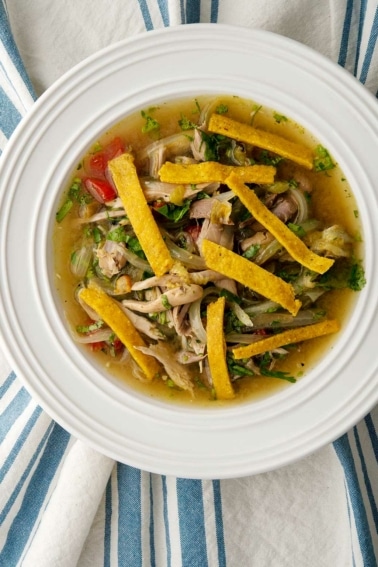
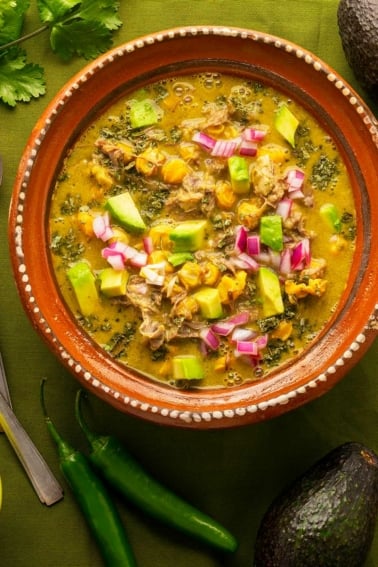
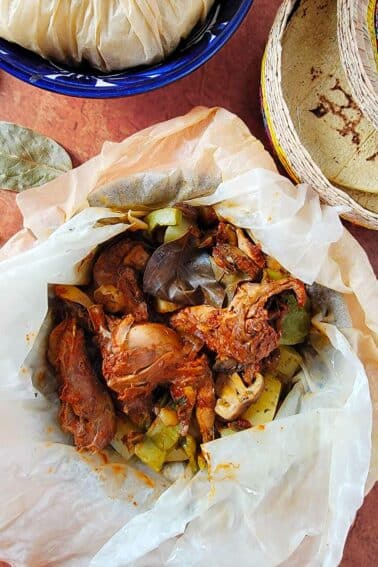

made this with mountain lion and holy cow it’s amazing. Hank your recipe for chile verde replaced my old one! Really bright flavors, amazing as leftovers and was a great”first meal” of mountain lion to ease into eating lion.
Fantastic! The reduction at the end took so long but was worth it. My chicken bone broth was clutch in this recipe. I really like your style of cooking
Well it’s Hatch chili season here on the East Coast, courtesy of distributors shipping them out from New Mexico to our east coast stores. One had some folks out with a typical propane roaster. I bought a bushel and had them roast most of them, but saved some so I could roast on the grill. Clearly didn’t turn out as well – It took a while to char the skins and cooked the chilis in the process. They’re useable but much softer that the true roasted ones. At any rate, I used largely your recipe for pork Chili verdi. Turned out great, not surprisingly. One thing I did was to save all the juices from the bags of roasted chilis. Have quite a bit. Used it on braising the pork, along with chicken stock. Also used it in making salsa verde. Have a little left frozen. Adds a nice touch and a bit of slickness on the tongue given the oils from the chilis. Hope you’re doing well Hank and settling in. Peace.
This turned out so great that I’ve already resolved to start canning Salsa Verde next year just so I can make this recipe faster and more often. Now I just need to work tomatillos into my garden…
Late summer I can a bunch of salsa verde. this is one of my favorite recipes to use it for
I made this today with some doe meat I harvested this weekend. I didn’t have any cilantro but it still turned out great. I may have over charred my tomatillos a little! I used 3 Jalapenos, 2 Anaheims and 2 Poblanos. The heat was about perfect for me. I ended up canning 4 pints.
Love this recipe! I planted several tomatillo plants and have slew of fruit. Would you recommend making the Verde sauce and pressure canning it, then when ready for the soup adding it to the meat portion and simmering; or would you make the whole recipe with the meat and pressure canning it? Thank you
Patrick: Yes, I do that a lot… meaning I do both. the whole stew is great pressure canned for a busy worknight, and the salsa itself is great canned for whatever you want to use it for.
Thank you!
Absolutely amazing. Well worth the amount of work it takes. I used a 45 pound male boar I harvested a few days ago and it was the perfect flavor. Added extra cilantro to add some character.
My growing season is done in my neck of the woods. As a result I have a bunch of green tomatoes I need to use up. I’m assuming these would work in place of the tomatillos?
Dan: Er… they are completely different, but yes, you can use them. You will want to add lime juice though, because green tomatillos are very acidic. Green tomatoes are not.
Awesome! It turned out great! I knew they weren’t the same, but I had green tomatoes to use. The lime juice was the ticket. While not the same as tomatillos, it still made an excellent green chili.
How well would this work with a black bear round roast?
Chris: Quite well. Go for it!
Just made chili verde with the black bear trimmings my husband intended to grind into burger. He thought it would be tough, but it is meltingly tender.
Have done this recipe with pheasant and elk, super tasty either way!
Great recipe, I usually can salsas verde in late summer which makes it go a little quicker. Left overs make great breakfast with some scrambled eggs
If you already have the salsa verde made and canned, how much would you add to make the chuli?
Miguel: With that much meat, four pounds or so, I’d use a full quart, although you could get away with less. Thin it with the braising liquid.
Hank:
The “note” to the recipe mentions vinegar, but I don’t see it on the list of ingredients. I suspect it goes in when the pork is braising and probably about a half a cup ought to do the trick.
Regards,
Mark
Mark: Oops. I clarified it. The note refers to salsa verde that is canned, which I add a little vinegar to just to be safe. You don’t need vinegar in this recipe.
There is a good truck that sometimes parks near our neighborhood that makes a purple tomatillo salsa…I don’t know the ingredients but it’s bracingly hot with a tangy sweetness, almost pineapple without the acidity. Unfortunately my Spanish is only sufficient for ordering food, not for understanding what’s in it 🙂
I don’t grow tomatillos, but I do find plenty of solanum nigrum growing wild and have used it as a substitute, including in your tomatillo salsa. I love chile verde, so I am thinking of trying it here, although I don’t know how the tiny berries will stand up to the roasting.
I braised a feral hog shoulder last week and had some wonderful pulled boar begging to be used. Tried this Chile Verde today and it is EXCEPTIONAL! This salsa will be a regular in my repertoire from now on.
Hank,
The funny thing about tomatillos, especially in places like California, is all it takes is someone planting them once and they’ll be around for a very long time. Yep, they go feral easily…they seem to be barely tamed to begin with. Heck, even here in WV, I’ve had them stick around several years after a single planting. This recipe is making me want to include them on this year’s planting schedule.
Ok this sounds delicious too, like all of your other recipes. I will be planting tomatillos this year!
Thank you.
Matt
Great recipe! We eat a lot of Chile verde. I can several gallons of tomatillo salsa every year and have a freezer full of roasted chiles from the garden. Add a big spoonful of sour cream to your bowl and it completely transforms the dish.
Hank
Do you use a different process to can it, versus canning vegetable or sauces?
Justin: When I can this, I pressure-can it in quarts for like 90 minutes at 10 psi. But the salsa itself can be water-bath canned. Those instructions are in the link for the salsa verde.